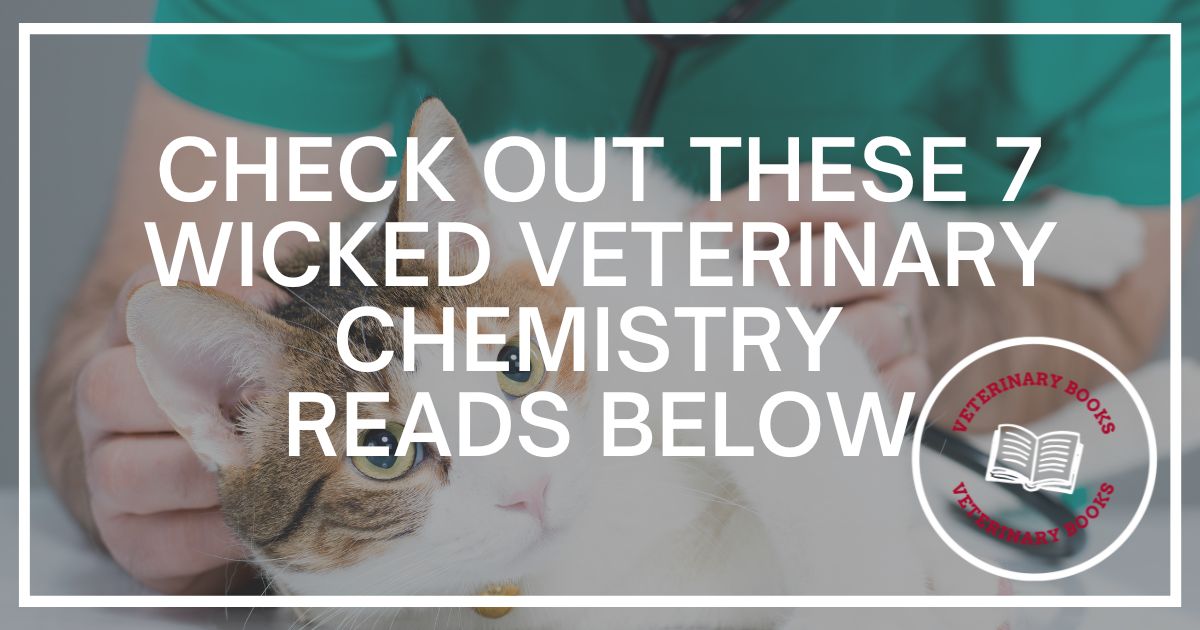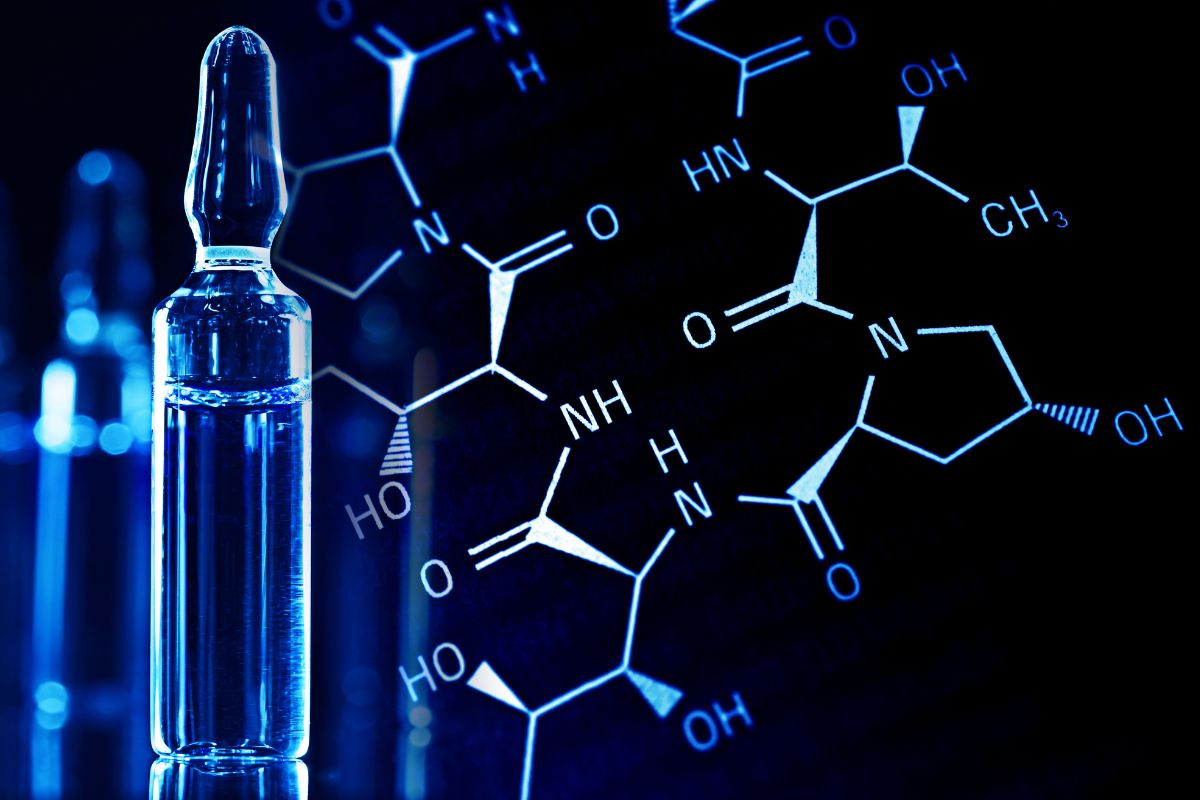What Does Veterinary Chemistry Entail?
In veterinary chemistry, vets identify illnesses in sick and healthy animals. They use chemistry to prescribe drugs and therapies and track the effectiveness of those treatments.
The most frequent use of chemistry is in the analysis of test results. Vets might check the blood pH of an animal using a veterinary chemistry panel. The veterinarian prescribes drugs that modify the animal’s internal chemistry by knowing what causes the pH to rise or fall.
















The Best Veterinary Chemistry Books to Own
Veterinary Hematology, Clinical Chemistry, and Cytology 3rd Edition
By Mary Anna Thrall (Editor), Glade Weiser (Editor), Robin W. Allison (Editor), Terry W. Campbell (Editor)
Book Details
Publisher: Wiley-Blackwell; 3rd edition (May 3, 2022)
Hardcover: 1,056 pages
Language: English
ISBN-10: 1119286409
ISBN-13: 978-1119286400
Item Weight: 6.15 pounds (2.8 kilograms)
Dimensions: 8.9 x 1.6 x 10.9 inches (22 x 4 x 27.6 centimeters)
The Third Edition of Veterinary Hematology, Clinical Chemistry, and Cytology thoroughly examines the fundamentals of veterinary lab testing and diagnosis. It also discusses cytology, hematology, and chemistry of common domestic and non-domestic species.
Readers will find a greater variety of clinical case presentations in this book, along with case data and narrative discussions, to foster skill development.
The book provides access to a companion website that delivers clinical cases and the figures from the book in PowerPoint. It is jam-packed with the knowledge that veterinary students, technicians, pathologists, and researchers will find beneficial.
This most recent edition features a brand-new chapter on laboratory diagnosis of infectious diseases, a section on veterinary cytology, and updated information that keeps up with the quickly evolving field of clinical pathology. It is heavily illustrated, with a strong practical emphasis.
The book contains:
- A thorough rundown of the fundamentals of laboratory testing and diagnosis with special emphasis on interpretative viewpoints and slide production methods.
- A comprehensive treatment of hematopathology in domestic animal species separates leukocytes, erythrocytes, platelets, bone marrow, hemostasis, and transfusion therapy into parts.
- Organized by the system, this comprehensive course of clinical biochemistry in domestic animals also includes electrochemical analysis of electrolyte and acid-base pathologies.
- A thorough discussion of domestic animal cytology structured according to specific collecting sites and the concepts of inflammation, infectious diseases, and cancer.
- Complete sections on hematology’s clinical biochemistry and experimental therapy in non-domestic mammals, birds, reptiles, fish, and amphibians.
From the back cover:
The newly revised Third Edition of Veterinary Hematology, Clinical Chemistry, and Cytology covers the principles of veterinary lab testing and diagnosis and the cytology, hematology, and chemistry of common domestic and non-domestic species.
Readers will find a greater variety of clinical case presentations in this book, along with case data and narrative discussions, to foster skill development. This most recent edition includes a brand-new section on veterinary cytology and a chapter on laboratory diagnosis of infectious diseases.
It also has well-updated information that keeps pace with the quickly developing field of clinical pathology. It has rich illustrations and plain writing, with a strong practical emphasis.
A one-stop resource on veterinary laboratory diagnostic methods and interpretation, Veterinary Hematology, Clinical Chemistry, and Cytology is appropriate for veterinary students, veterinary technicians, general practitioners, and specialists. Get the book in both hardback and e-book formats.
Textbook of Veterinary Physiological Chemistry-3rd Edition
By Larry R. Engelking (Author)
Book Details
ASIN: 0123919096
Publisher: Academic Press; 3rd edition (August 4, 2014)
Paperback: 786 pages
Language: English
ISBN-10: 9780123919090
ISBN-13: 978-0123919090
Item Weight: 4.65 pounds (2 kilograms)
Dimensions: 8.51 x 1.5 x 10.89 inches (21 x 3.8 x 27.6 centimeters)
This book provides thorough coverage of biochemical principles for students and practitioners of veterinary medicine, bridging the gap between clinical science and basic topics. This handbook addresses cellular-level principles relevant to whole-body physiologic processes.
All this is through a reader-friendly, understandable manner, making it the only recent biochemistry book produced particularly for the veterinary sector. The author wrote each chapter in a clear, short style, with an overview summary section.
Multiple illustrations help the reader understand the topic, explicit learning objectives, and chapter-ending study questions to assess knowledge. The Text offers fresh graphics and an instructor website with updated PowerPoint images.
This is helpful to students and lecturers from a variety of educational backgrounds. The depth and range of learning resources increase by adding sectional exams and case studies to this version.
The book contains:
- Fresh case examples show how you can use ideas in practice.
- Thorough sectoral tests for self-evaluation
- Lecture slides and updated PowerPoint graphics for the instructor’s website to improve teaching and learning.
- Concise language to facilitate quick comprehension
From the back cover
This third edition comprehensively covers biochemical concepts for veterinary medicine students and professionals. This handbook addresses cellular-level principles relevant to whole-body physiologic processes in a reader-friendly, understandable manner, making it the only recent biochemistry book produced particularly for the veterinary sector.
The author wrote each chapter in a clear, short way and includes an overview summary section, several illustrations to help the reader grasp the material, specific learning objectives, and study questions at the end to gauge knowledge.
The book is helpful to students and lecturers from various educational backgrounds, thanks to new graphics and an instructor website with updated PowerPoint images. This edition’s additional sectional exams and case studies broaden and deepen the scope of learning resources.
Physiological Chemistry or Veterinary Biochemistry courses for first-year veterinary students. Additionally, graduate students studying animal science, veterinary pharmacy students, and students in physiology courses. The book is available in eTextbook and paperback formats.
Manual of Veterinary Clinical Chemistry: A Case Study Approach 1st Edition
By Leslie C. Sharkey (Author), Judith Radin (Author)
Book Details
Publisher: Teton NewMedia; 1st edition (April 15, 2010)
Language: English
Paperback: 424 pages
ISBN-10: 1591610184
ISBN-13: 978-1591610182
Item Weight: 2.31 pounds (1 kilogram)
Dimensions: 7 x 1.25 x 9.75 inches (17.7 x 3 x 24.7 centimeters)
Veterinary students and non-specialists can utilize this case study-based workbook as a reference to the efficient use and interpretation of clinical chemistry laboratory procedures in domestic animals. The more than 100 case studies feature actual patients and outcomes in canines, felines, horses, llamas, alpacas, potbellied pigs, and ferrets.
These include the patient’s medical history, the results of the physical examination, and clinicopathologic information like CBC, urine, cytology, or fluid analysis. Each patient receives a summary detailing the follow-up testing results and their response to treatment.
Numerous cases of common diseases illustrate the variation of clinicopathologic results with the same diagnosis based on unique patient circumstances. It mentions diagnoses that show various clinical symptoms and similar test results.
Although each chapter focuses on particular facets of the chemistry panel, each case includes supplementary data that gives context to the author’s interpretation of the clinical chemistry pane. This includes signalment, history, hematology, coagulation, radiography, gross photographs, cytology, and other diagnostics for endocrinopathies.
Additionally, readers who want to challenge themselves by independently coming up with their interpretation can do so thanks to the writers’ in-depth analyses of each instance, which include built-in feedback. Each chapter concludes with an overview that lists things to think about and refers to particular cases demonstrating these ideas.
This paper provides a “real-world” framework for combining patient information, clinical indicators, and laboratory results into a reasonable interpretation. The text may not be as interesting to people interested in ruminant or exotic animals because it focuses mainly on canine, feline, and, to a lesser extent, equestrian.
However, we discovered the authors’ strategy is pleasant and compelling. Therefore, we would advise anyone—regardless of specialty—looking for a practical manual for clinical chemistry interpretation to buy this book. Kindle and paperback are the available formats.
Clinical Case Presentations for Veterinary Hematology and Clinical Chemistry
By Mary Anna Thrall (Author), Dale R. Baker (Author), E. Duane Lassen (Author)
Book Details
Publisher: Wiley-Blackwell; 1st edition (November 18, 2005)
Paperback:100 pages
Language: English
ISBN-10: 0781757991
ISBN-13: 978-0781757997
Item Weight: 9.8 ounces (0.28 kilograms)
Dimensions: 8.5 x 0.25 x 10.95 inches (21.6 x 0.6 x 27.8 centimeters)
This is a textbook for students and a clinical practitioner’s reference. It provides trustworthy information that practitioners can use to perform diagnostic procedures, view relevant clinical pathology, and accurately interpret laboratory results. This will enable them to get the most appropriate treatment for various domestic and exotic animal species.
The reader can compare instances of normal and abnormal blood cells using over 500 photographs (including 350 full-color photos), which have they enhanced using digital imaging techniques. This makes it easier to make a precise visual diagnosis for various problems.
The reader can also identify disease trends and improve diagnosis accuracy by using more than 50 in-depth case studies organized by primary system abnormalities. Each case study comprises a signalment, history, physical examination findings, and test data.
It then provides in-depth interpretations, conclusions, and results. An emphasis on aberrant laboratory findings follows lab analysis of each system for various species. The audience can follow each step of the diagnostic process using this method.
This strengthens the reader’s interpretive abilities by highlighting the clinical importance of each observed aberration for many bird species and uncommon pets. Respected authors enable readers to learn from clinical chemistry and veterinary hematology specialists.
From the back cover:
There is a publication of a new, attractive, full-color reference on veterinary hematology and clinical chemistry that is thorough and useful. Readers will find similarly concise and clear coverage of both hematology and clinical chemistry for domestic and foreign species, from fundamental concepts and laboratory procedures through diagnostic evaluation.
This book is a must-have for any veterinary reference library due to features including multiple full-color and black-and-white graphics, coverage of avian and exotic hematology, and extensive use of case studies. The formats of the book are paperback and hardcover.
Veterinary Hematology and Clinical Chemistry 1st Edition
By Mary Anna Thrall (Editor), Dale C. Baker (Editor), Terry W. Campbell (Editor)
Book Details
Publisher: Lippincott Williams & Wilkins; 1st edition (November 22, 2004)
Hardcover: 618 pages
Language: English
ISBN-10: 0781768500
ISBN-13: 978-0781768504
Item Weight: 4.82 pounds (2.2 kilograms)
Dimensions: 8.9 x 1.45 x 11.32 inches (22.6 x 3.6 x 28.7 centimeters)
The first edition of Veterinary Hematology and Clinical Chemistry provides an accessible guide to veterinary laboratory diagnostic procedures and interpretation. The book gives an overview of these essential veterinary abilities and covers hematology and chemistry for various species, including fish, birds, reptiles, and amphibians.
This edition has many updates and new chapters, including ones on molecular diagnostics of hematologic malignancies and lipid pathology. It also includes significant revisions to the chapter on data interpretation to provide introductory guidance.
There is also up-to-date information on immunodiagnostics and laboratory diagnostics of renal, endocrine, and calcium metabolic pathologies.
The book commences with a discussion of the fundamentals of laboratory diagnosis before going into great detail about the hematology and chemistry of both domestic and exotic species. Clinical case presentations are large and included in the book’s main body. They provide case data and offer narrative discussions to promote skills.
The indispensable addition to any veterinary library is Veterinary Hematology and Clinical Chemistry, which is full of knowledge helpful for veterinarians, technicians, pathologists, and researchers.
This book contains:
- Guide on veterinary laboratory diagnostic procedures and interpretation that is clear and straightforward
- Important details on birds, reptiles, amphibians, and fish, as well as information on hematology and chemistry for a variety of species
- A thorough explanation of laboratory tests, diagnoses, and basic ideas.
- Updates content throughout to reflect advancements in the field and adds new chapters on lipid pathology and molecular diagnosis of hematologic malignancies
- Seventy-four case studies are available to help with the diagnosis and interpretation of test findings.
From the back cover:
This stunning full-color reference is a comprehensive, helpful manual for veterinary clinical chemistry and hematology. Readers will find similarly concise and clear coverage of both hematology and clinical chemistry for domestic and foreign species, from fundamental concepts and laboratory procedures through diagnostic evaluation.
This book is a must-have for any veterinary reference library due to features including multiple full-color and black-and-white graphics, coverage of avian and exotic hematology, and extensive use of case studies.
You will find detailed case studies collected from animal medical data in the Free Supplemental Casebook: Clinical Case Presentations for Veterinary Hematology and Clinical Chemistry. You can identify disease trends and improve your diagnostic precision with the help of more than 50 case discussions.
You will receive guidance from signalment, history, physical examination findings, and test results through in-depth interpretations, conclusions, and outcomes. The book is available in hardcover format.
Veterinary Hematology and Clinical Chemistry 2nd Edition
By Mary Anna Thrall (Editor), Glade Weiser (Editor), Robin W. Allison (Editor), Terry W. Campbell (Editor)
Book Details
Publisher: Lippincott Williams & Wilkins; 1st edition (November 22, 2004)
Hardcover: 618 pages
Language: English
ISBN-10: 0781768500
ISBN-13: 978-0781768504
Item Weight: 4.82 pounds (2.1 kilograms)
Dimensions: 8.9 x 1.45 x 11.32 inches (22.6 x 3.6 x 28.7 centimeters)
The book is user-friendly and a well-illustrated reference on veterinary laboratory diagnostic procedures. The book gives an overview of these essential veterinary abilities and covers hematology and chemistry for various species, including fish, birds, reptiles, and amphibians.
This second edition has many updates and new chapters, including ones on molecular diagnostics of hematologic malignancies and lipid pathology. It also includes significant revisions to the chapter on data interpretation to provide introductory guidance.
It also contains up-to-date information on immunodiagnostics and laboratory diagnostics of endocrine, renal, and calcium metabolic pathologies.
The book discusses the fundamentals of laboratory diagnosis before going into great detail about the hematology and chemistry of both domestic and exotic species. There is the inclusion of enlarged clinical case presentations in the book’s main body.
They provide case data and offer narrative discussions to promote skills. The indispensable addition to any veterinary library is Veterinary Hematology and Clinical Chemistry, which is full of knowledge helpful for veterinarians, technicians, pathologists, and researchers.
This book contains:
- Guide on veterinary laboratory diagnostic procedures and interpretation that is clear and straightforward
- It includes important details on birds, reptiles, amphibians, fish, and information on hematology and chemistry for various species.
- Includes a thorough explanation of laboratory tests and diagnosis and basic ideas.
- Updates content to reflect advancements in the field and adds new chapters on lipid pathology and molecular diagnosis of hematologic malignancies.
- Includes access to a companion website with PowerPoint test questions
Get the book in hardcover format.
Equine Hematology, Cytology, and Clinical Chemistry 2nd Edition
By Raquel M. Walton (Editor), Rick L. Cowell (Editor), Amy C. Valenciano (Editor)
Book Details
Publisher: Wiley-Blackwell; 2nd edition (February 3, 2021)
Hardcover: 352 pages
Language: English
ISBN-10: 1119500249
ISBN-13: 978-1119500247
Item Weight: 2.64 pounds (1.2 kilograms)
Dimensions: 8.5 x 0.8 x 10.9 inches (21.5 x 2 x 27.7 centimeters)
The brand-new Equine Hematology, Cytology, and Clinical Chemistry incorporates important cytopathology information from Diagnostic Cytology and Hematology of the Horse. It has information on hematology and clinical chemistry from the first edition of Equine Clinical Pathology to create a truly comprehensive reference on clinical pathology in equids.
The editors revised this second edition and also expanded it throughout. It includes brand-new chapters on cytopathology and bone marrow examination in addition to more pictures, information, and new insights from earlier chapters.
The author organized the book logically for simple reference, and it intends to convey information in a clear, brief, and clinically relevant manner. Numerous graphs, tables, photos, and information condensed for readability support the text.
This book contains:
- Extensive details on hematology, clinical chemistry, and cytopathology in equids with a focus on clinical pathology in horses.
- Hundreds of high-quality photos present equine disease from a systems-based, clinicopathological perspective.
- Contributions from veterinary experts with a thorough understanding of clinical pathology.
This is an essential resource for equine practitioners, clinical pathologists, residents, and veterinary students. It is a must-have purchase for anyone using hematology, clinical chemistry, and cytology in equine patients. Get the book in hardcover and Kindle versions.
Frequently Asked Questions
Q: How do veterinarians use Chemistry in veterinary medicine?
A: Veterinarians use Clinical chemistry and other laboratory tests to diagnose disease, monitor disease progression or response to therapy, and screen for the presence of underlying disease in otherwise healthy animals.
Q: Do vets need to know chemistry?
A: There is no conclusive answer to this question because the field of veterinary care is continually changing, as are the educational requirements for veterinarians. Many experts, however, believe that a basic understanding of chemistry is necessary for veterinarians since it can give them a better understanding of how the body functions and how different medications and treatments can affect animals.
Q: Why do you need Chemistry to be a Vet?
A: For veterinarians, chemistry is crucial because it helps them understand how the body operates and how diseases emerge. By understanding the body’s chemistry, vets can better diagnose and treat health problems.
In Conclusion
The books above are great additions to any animal lover. The Equine Hematology, Cytology, and clinical Chemistry 2nd Edition are what we love the most. Overall, any horse clinician, pathologist, clinical pathologist, or veterinary student should add this book to their library.
Since the paper used is of good quality and the binding and cover are sturdy, this book should age well and not degrade or fall apart, as is sometimes the case with less well-constructed books.
A wide range of target people will find this book well-organized and user-friendly, including equine-focused veterinary students, interns, residents, practitioners, and clinical pathologists looking to increase their understanding of equine-specific entities. You can get a diagnosis with a veterinary chemistry analyzer and any of these books.













